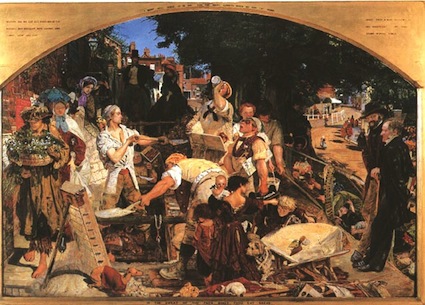
(Ford Madox Brown, Work: Manchester Art Gallery)
Our road is finally being resurfaced: the most immediately local excitement in a long time and a teasing reminder of what it could be like were there not—as there usually are—bloody cars parked bumper to bumper on both sides of the road. I say it’s being resurfaced: that’s the advertised plan, anyway. It was advertised once before but the designated two days coincided with the heat wave, more, two of the hottest days on record, so they very sensibly postponed the work.
Yesterday, then, there was a good deal of noise, and a nifty vehicle kept whizzing up and down the road, with no discernible purpose that we could see, until we finally realised that the whizzing was probably the point. An open road, a nippy vehicle and endless fun to be had. So today was, is, presumably The Day. There’s been a bit of coming and going but no sign of any actual resurfacing yet.
The pavements – and every pedestrian path hereabouts – are in a parlous condition, offering plenty of opportunities to break your neck or at least an ankle; but, as is well established, pedestrians are very low down the food chain. Roads, on the other hand – and yet, getting on towards lunchtime, a car just passed along what I supposed was the still-closed road – and I’m beginning to wonder.
Meanwhile, today is the 4th August, a date written in very large letters in the minds and margins of most students and scholars of modern history. Fordian scholars too, aware that he slipped that date into the text of The Good Soldier some sixteen times. Right up until 1914, of course, it’s just a date. Even on the day itself, it hasn’t happened, at least in Britain, until 11:00 p.m.
Fifty years earlier, the younger sister of Violet Hunt (novelist, suffragist, partner of Ford Madox Ford for ten fraught years) was born. Venetia Margaret Hunt, usually known as ‘Venice’, was named after Ruskin’s famous work, The Stones of Venice (1851-53) and Ruskin became her godfather. On the same day in 1899, poet and short story writer Walter de la Mare married Elfrida Ingpen, at a a private ceremony in a Battersea church.[1] The year before the Great War, D. H. Lawrence’s sister Ada was married to William Clarke, 4 August 1913. On the portentous day itself, the novelist Julian Barnes’ grandparents were married, Stanley Spencer’s sister Florence had her birthday and Siegfried Sassoon’s, his ‘impetuosity’ probably having made him the first War poet to have enlisted, his Army Medical done and dusted on 1 August , so ‘at the official outbreak of War on 4 August he was in ill-fitting khaki.’[2]

(Siegfried Sassoon via the BBC)
It has always been, in fact, a popular day for birthdays in the arts: Percy Shelley and Walter Pater, W. H. Hudson and Knut Hamsun, Louis Armstrong and Witold Gombrowicz.
Some years after that war, the poet and maker David Jones stayed with his friend Helen Sutherland at Rock Hall, Northumberland. He made his third trip there on 4 August 1931. At the start and end of each visit, Jones would be driven past the Duke of Northumberland’s castle. Helen told him this was on the site of Lancelot’s castle, Joyous Guard – and the supposed place of his burial. ‘With this association in mind’, his biographer Thomas Dilworth wrote, ‘Jones referred to the church at Rock as “the Chapel Perilous”, the place of terrifying enchantment that Lancelot enters – an episode in Malory that reminded him of his experience at night in Mametz Wood.’[3]
Looking back now, I’m struck by a sentence in the ‘Preface’ to Jones’s poem, written nearly ninety years ago: ‘Just as now there are glimpses in our ways of another England—yet we know the truth. Even while we watch the boatman mending his sail, the petroleum is hurting the sea.’[4]
As for that resurfacing – cars are passing and parking often now. The closed road has been thoroughly unclosed. The sun is beating down on the same surface. The workmen have packed up and gone, nifty vehicles and large vans alike, having left undone those things that they ought to have done. There will be, of course, no explanation. Still, the renewed quietness enables me to hear more distinctly Harry the Cat prematurely yowling for his tea. Every cloud, silver lining, sunny side of the street, all that.
Notes
[1] Barbara Belford, Violet: The Story of the Irrepressible Violet Hunt and her Circle of Lovers and Friends—Ford Madox Ford, H. G. Wells, Somerset Maugham, and Henry James (New York: Simon and Schuster, 1990), 29; Theresa Whistler, The Life of Walter de la Mare: Imagination of the Heart (London: Duckworth, 2003), 89.
[2] Letters of D. H. Lawrence II, June 1913-October 1916, edited by George J. Zytaruk and James T. Boulton (Cambridge: Cambridge University Press, 1981), 38 n; Julian Barnes, Nothing to be Frightened of (London: Jonathan Cape 2008), 28; Kenneth Pople, Stanley Spencer: A Biography (London: Harper Collins, 1991), 55; Jean Moorcroft Wilson, Siegfried Sassoon: The Making of a War Poet. A Biography (1886-1918) (London: Duckworth, 1998), 180.
[3] Thomas Dilworth, David Jones: Engraver, Soldier, Painter, Poet (London: Jonathan Cape, 2017), 140-142.
[4] David Jones, In Parenthesis (1937; Faber 1963), ix.

Dear Paul,
So many pitted, blocked roads; so much re-paving needed. But squeaking by is, apparently, all the thoroughfare one can expect. Well, we squeaked by August 4. I’ve been superstitious about this August, given the incendiary global mess. I suppose that mess too will just creep forward–or slouch forward. Thank you for witnessing the crawl, and for your indignation in response to it.
LikeLike